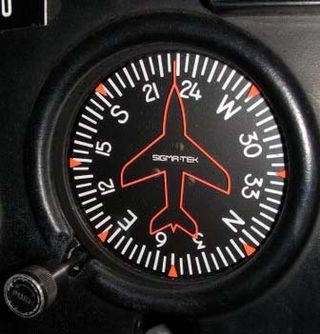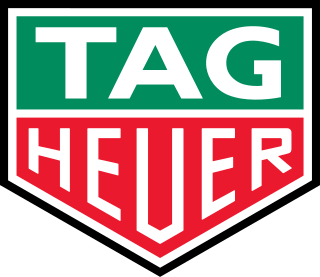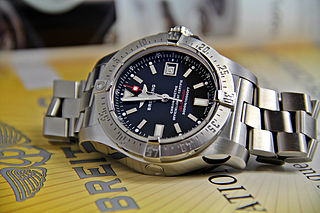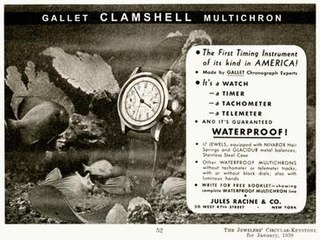
A watch is a portable timepiece intended to be carried or worn by a person. It is designed to keep a consistent movement despite the motions caused by the person's activities. A wristwatch is designed to be worn around the wrist, attached by a watch strap or other type of bracelet, including metal bands, leather straps, or any other kind of bracelet. A pocket watch is designed for a person to carry in a pocket, often attached to a chain.

The heading indicator (HI), also known as a directional gyro (DG) or direction indicator (DI), is a flight instrument used in an aircraft to inform the pilot of the aircraft's heading.

TAG Heuer S.A. is a Swiss luxury watchmaker. The company began as Uhrenmanufaktur Heuer AG, founded in 1860 by Edouard Heuer in St-Imier, Switzerland. In 1985, TAG Group purchased a majority stake in the company, forming TAG Heuer. In 1999, French luxury goods conglomerate LVMH bought nearly 100 percent of the Swiss company.The name TAG Heuer combines the initials of "Techniques d'Avant Garde" and the founder's surname.

A stopwatch is a timepiece designed to measure the amount of time that elapses between its activation and deactivation.

A chronograph is a specific type of watch that is used as a stopwatch combined with a display watch. A basic chronograph has an independent sweep second hand and a minute sub-dial; it can be started, stopped, and returned to zero by successive pressure on the stem. More complex chronographs use additional complications and can have multiple sub-dials to measure seconds, minutes, hours and even fractions of a second. In addition, many modern chronographs use moveable bezels as tachymeters for rapid calculations of speed or distance. Louis Moinet invented the chronograph in 1816 for use in tracking astronomical objects. Chronographs were also used heavily in artillery fire in the mid to late 1800s. More modern uses of chronographs involve aircraft piloting, auto racing, diving and submarine maneuvering.
A. Lange & Söhne is a trademark of Lange Uhren GmbH, a German manufacturer of luxury and prestige watches. The company was originally founded by Ferdinand Adolph Lange in Glashütte, Kingdom of Saxony in 1845. The original A. Lange & Söhne was nationalized and ceased to exist in 1948, following the occupation by the Soviet Union after World War II. The current A. Lange & Söhne trademark was re-registered when Lange Uhren GmbH was founded in 1990 by Walter Lange, the great-grandson of Ferdinand Adolph Lange.

Zenith SA is a Swiss luxury watchmaker. The company was started in 1865 by Georges Favre-Jacot in Le Locle in the canton of Neuchâtel and is one of the oldest continuously operating watchmakers. Favre-Jacot invented the concept of "in house movements", believing that only through control of the entire watchmaking process could the highest quality be achieved. Zenith was purchased by LVMH in November 1999, becoming one of several brands in its watch and jewellery division, which includes TAG Heuer and Hublot. Julien Tornare is president and CEO.

In horology, a complication is any feature of a timepiece beyond the display of hours, minutes and seconds. A timepiece indicating only hours, minutes and seconds is known as a simple movement. Common complications include date or day-of-the-week indicators, alarms, chronographs (stopwatches), and automatic winding mechanisms. Complications may be found in any clock, but they are most notable in mechanical watches where the small size makes them difficult to design and assemble. A typical date-display chronograph may have up to 250 parts, while a particularly complex watch may have a thousand or more parts. Watches with several complications are referred to as grandes complications.

Compagnie des Montres Longines, Francillon S.A., or simply Longines, is a Swiss luxury watchmaker based in Saint-Imier, Switzerland. Founded by Auguste Agassiz in 1832, the company has been a subsidiary of the Swiss Swatch Group and its predecessors since 1983. Its winged hourglass logo, registered in 1889, is the oldest unchanged active trademark registered with WIPO.

Omega Speedmaster is a line of chronograph wristwatches produced by Omega SA. While chronographs have been around since the late 1800s, Omega first introduced this line of chronographs in 1957. Since then, many different chronograph movements have been marketed under the Speedmaster name. Astronaut Walter Schirra was the first person to wear one in space in 1962 during his Mercury-Atlas 8 mission. The manual winding Speedmaster Professional or "Moonwatch" is the best-known and longest-produced; it was worn during the first American spacewalk as part of NASA's Gemini 4 mission, and was the first watch worn by an astronaut walking on the Moon during the Apollo 11 mission. The Speedmaster Professional remains one of several watches qualified by NASA for spaceflight, and is still the only one so qualified for EVA. The Speedmaster line also includes other models, including analog-digital and automatic mechanical watches.

Automatic quartz is a collective term describing watch movements that combine a self-winding rotor mechanism to generate electricity with a piezoelectric quartz crystal as its timing element. Such movements aim to provide the advantages of quartz without the inconvenience and environmental impact of batteries. Several manufacturers employ this technique.

The Rolex Cosmograph Daytona is a mechanical chronograph wristwatch designed to meet the needs of racing drivers by measuring elapsed time and calculating average speed. Its name refers to Daytona, Florida, where racing flourished in the early 20th century. It has been manufactured by Rolex since 1963 in three distinct generations ; the second series was introduced in 1988, and the third in 2000. While cosmetically similar, the second series introduced a self-winding movement, and the third series brought manufacture of the movement in-house to Rolex.

The Double chronograph, also known as a split-seconds chronograph, is a watch that includes two distinct stopwatch mechanisms in order to measure two separate events concurrently and/or comparatively. It is often confused with the flyback chronograph.

Sinn is a German manufacturer of mechanical and quartz wristwatches based in Frankfurt am Main. The company was founded in 1961 by flight instructor and pilot Helmut Sinn (1916–2018) under the name ‘Helmut Sinn Spezialuhren’.

A diving watch, also commonly referred to as a diver's or dive watch, is a watch designed for underwater diving that features, as a minimum, a water resistance greater than 1.1 MPa (11 atm), the equivalent of 100 m (330 ft). The typical diver's watch will have a water resistance of around 200 to 300 m, though modern technology allows the creation of diving watches that can go much deeper. A true contemporary diver's watch is in accordance with the ISO 6425 standard, which defines test standards and features for watches suitable for diving with underwater breathing apparatus in depths of 100 m (330 ft) or more. Watches conforming to ISO 6425 are marked with the word DIVER'S to distinguish ISO 6425 conformant diving watches from watches that might not be suitable for actual scuba diving.

Gallet (ˈgæl.eɪ) is a historic Swiss manufacturer of high-end timepieces for professional, military, sports, racing, and aviation use. Gallet is the world's oldest clock making house with history dating back to Humbertus Gallet, a clock maker who became a citizen of Geneva in 1466. The Gallet & Cie name was officially registered by Julien Gallet (1806–1849) in 1826, who moved the family business from Geneva to La Chaux-de-Fonds, Switzerland. Prior to this date, operations commenced under the name of each of the Gallet family patriarchs.

The Clamshell, manufactured between 1936 and 1951 by the Gallet Watch Company of Switzerland, is the world's first water resistant wrist chronograph.

The Omega Bullhead was introduced in 1969 as part of the Chronostop range, it was marketed as drivers / rally watch and was nicknamed the "Bullhead" because of the configuration of the winding crown being located at 12 o'clock with the chronograph pushers on either side.

Carl F. Bucherer is a Swiss watch company based in Lucerne, Switzerland, which manufactures luxury men's and women's mechanical watches. From its founding in 1888 until its sale in 2023, the company was wholly owned by the Bucherer family, making it one of the oldest luxury Swiss watchmakers continuously held by the founding family. The company was run by the original family's third generation, with Jörg G. Bucherer serving as chairman of the board.

The TX Watch Company was launched in 2006 by the Timex Group, an international holding group and corporate parent of global watchmaking companies, including Timex Group USA, Inc., TMX Philippines, Inc., and Timex Group India Ltd.




















